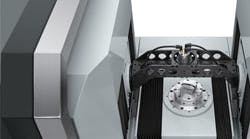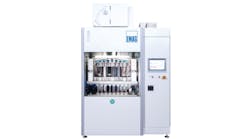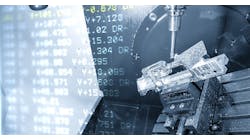Mori Seiki's NN1000DCG 5-axis machine.
Many shops are solidifying their competitive standing by incorporating 5-axis machining and taking on low-volume, high-accuracy complex jobs. But in this process some shops, especially those doing work with micron-scale features or surface-finish requirements in the singlenanometer range, often reach accuracy limits when using conventional machine tools.
In these situations, machine tool builder Mori Seiki recommends that shops consider “ultra-precise” 5-axis machines. Used in clean, temperature-stable environments (at least +/- 1 degree C.), these machines easily match the most demanding standards for accuracy.
One of Mori Seiki’s ultraprecision 5-axis machines is the NN1000DCG for ultraprecise linear scribing and milling. The symmetrically configured machine feature’s the company’s DCG (driven at the center of gravity) technology and a special, closed-loop structure.
According to Adam Hansel, COO of Mori Seiki's Digital Technology Lab, the reduction of off-axis disturbances is critical in ultraprecision machining. A DCG machine structure, and one that is fully counterbalanced, ensures smooth machine movement. In addition, the NN1000’s closed-loop structure increases machine stiffness.
“While other machines typically employ cantilevered spindles, the NN1000 closedloop structure not only makes for a more rigid machine, but also provides excellent operator access to workpieces and tooling for in-machine measuring and job set up,” pointed out Hansel.
Mori Seiki equips the NN1000 with air bearings on linear and rotary axes to eliminate mechanical contact and provide the highest level of precision.
An air turbine that provides precision and reduced thermal generation drives the machine’s milling spindle, which also spins on air bearings. For ultra-precision positioning, the machine’s linear axes feature 34-picometer- resolution scales.
Although the X, Y, and Zaxis travels on the NN1000 measure 4.7 in., 5.9 in., and 2.0 in., Zach Piner, general manager of Mori Seiki' Mechanical Technology Group, said the machine’s design could definitely be applied to a larger format machine. But, he added that the exact construction of the machine would have to be evaluated based on the exact intended application.
“Some of the main target markets for the NN1000 are optical and micro molds. However, many markets are emerging as engineers learn that these kinds of machines exi s t . Many engine e r s would not have considered designing such complex and precise part features because they did not know that a machine existed that could achieve them,” commented Piner.






